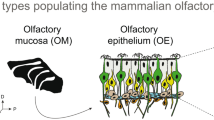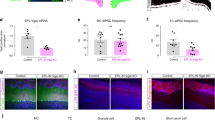Abstract
Learning in the accessory olfactory bulb is modelled mathematically by means of a set of coupled oscillator equations to describe the ongoing activity. The modification of this activity by experience is shown to lead to a change of the transfer function of the AOB as an input-output device. This leads both to a test of the model and a means of discovering how the later stages of the brain may use the AOB output. Our discussion is limited to a specific form of learning in the mouse, but may have more general applicability.
Similar content being viewed by others
References
Baird B (1986) Nonlinear dynamics of pattern formation and pattern recognition in the rabbit olfactory bulb. Physica 22D:150–175
Brennan PA, Keverne EB (1985) Impairment of olfactory memory by local infusions of non-selective excitatory amino acid receptor antagonists into the accessory olfactory bulb. Neuroscience 33:463–468
Bressler SL (1987) Relation of olfactory bulb and cortex. Brain Res 409:285–301
Dyer RG (1985) Neural signals for oxytocin and LH release. Oxford Rev Reprod Biol 7:223–260
Eckhorn R, Bauer R, Jordan W, Brosch M, Kruse W, Munk M, Reitboeck HJ (1988) Coherent oscillations: a mechanism of feature linking in the visual cortex? Biol Cybern 60:121–139
Freeman WJ (1975) Mass action in the nervous system. Academic Press, New York
Gray CM, Singer W (1987) Soc Neurosci (abstr) 404:3
Gray CM, Konig P, Engel A, Singer W (1989) Oscillatory responses in cat visual cortex exhibit inter-columnar synchronisation which reflects global stimulus properties. Nature 338:334–337
Gray CM, Engel AK, Konig P, Singer W (1990) Stimulus-dependent neuronal oscillations in cat visual cortex 1. Receptive field properties and feature dependence. Eur J Neurosci 2:588–619
Jack J, Noble D, Tsien RW (1975) Electric current flow in excitable cells. Oxford University Press, Oxford
Kaba H, Rossner AE, Keverne EB (1988) Hormonal enhancement of neurogenesis and its relationship to the duration of olfactory memory. Neuroscience 24:93–98
Keverne EB (1983) Pheromonal influences on the endocrine regulation of reproduction. Trends Neurosci 1:381–384
Keverne EB, de la Riva C (1982) Pheromones in mice: reciprocal interaction between the nose and brain. Nature 296:148–150
Larkman A (1990) Invited talk: “Real Neurons”. Neural Computing Meeting, British Neural Net Society
Li Z, Hopfield J (1985) Modeling the olfactory bulb and its neural oscillatory processings. Biol Cybern 61:379–392
Rosser AE, Keverne EB (1985) The importance of central noradrenergic neurones in the formation of an olfactory memory in the prevention of pregnancy block. Neuroscience 15:1141–1147
Rosser AE, Remfry CJ, Keverne EB (1985) Restricted exposure of mice to primer pheromones coincident with prolactin surges blocks pregnancy by changing hypothalamic dopamine release. J Reprod Fertil 87:553–559
Stratford K, Mason A, Larkman A, Major G, Jack J (1989) Modelling of pyramidal neurones in the visual cortex. In: Durbin R, Miall C, Mitchison G (eds) The computing neuron. Addison-Wesley, Reading Mass, pp 296–321
Yao Y, Freeman WJ (1985) Pattern recognition in the olfactory cortex. Proc Int J Cont Neural Networks 1:699–704
Author information
Authors and Affiliations
Rights and permissions
About this article
Cite this article
Taylor, J.G., Keverne, E.B. Accessory olfactory learning. Biol. Cybern. 64, 301–305 (1991). https://doi.org/10.1007/BF00199593
Received:
Accepted:
Issue Date:
DOI: https://doi.org/10.1007/BF00199593




